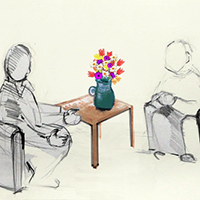Empathy as core to the development of holding and recognition: the case of Garret

Submitted: March 16, 2020
Accepted: June 13, 2020
Published: September 18, 2020
Accepted: June 13, 2020
Abstract Views: 1346
PDF: 665
HTML: 28
HTML: 28
Publisher's note
All claims expressed in this article are solely those of the authors and do not necessarily represent those of their affiliated organizations, or those of the publisher, the editors and the reviewers. Any product that may be evaluated in this article or claim that may be made by its manufacturer is not guaranteed or endorsed by the publisher.
All claims expressed in this article are solely those of the authors and do not necessarily represent those of their affiliated organizations, or those of the publisher, the editors and the reviewers. Any product that may be evaluated in this article or claim that may be made by its manufacturer is not guaranteed or endorsed by the publisher.
Similar Articles
- Federica Bonazza, Lidia Borghi, Eugenia Cao di San Marco, Kyrie Piscopo, Francesca Bai, Antonella d’Arminio Monforte, Elena Vegni, Psychological outcomes after hospitalization for COVID-19: data from a multidisciplinary follow-up screening program for recovered patients , Research in Psychotherapy: Psychopathology, Process and Outcome: Vol. 23 No. 3 (2020)
- Cristina Marogna, Chiara Masaro, Vincenzo Calvo, Simona Ghedin, Floriana Caccamo, The extended unconscious group field and metabolization of pandemic experience: dreaming together to keep cohesion alive , Research in Psychotherapy: Psychopathology, Process and Outcome: Vol. 25 No. 3 (2022): SPECIAL ISSUE: "Group psychotherapy: between settled benchmarks and new horizons"
- Alvaro E. Carrasco, Acceptability of an adventure video game in the treatment of female adolescents with symptoms of depression , Research in Psychotherapy: Psychopathology, Process and Outcome: Vol. 19 No. 1 (2016): Special issue on Qualitative and Quantitative Research in Child and Adolescent Psychotherapy: part 2
- Antonino Carcione, Marta Santonastaso, Francesca Sferruzza, Ilaria Riccardi, Esoteric power, useless, useful: considerations about dreams in cognitive-behavioural therapy , Research in Psychotherapy: Psychopathology, Process and Outcome: Vol. 24 No. 2 (2021): SPECIAL ISSUE "Working on dreams, from psychotherapy to neuroscience"
- Giorgio Falgares, Giulia Costanzo, Giovanna Manna, Dorian A. Lamis, Childhood emotional maltreatment and internalizing problems in a non-clinical sample of adolescents: a moderated-mediation model of insecure anxious attachment style and gender , Research in Psychotherapy: Psychopathology, Process and Outcome: Vol. 27 No. 2 (2024)
- Christin Janine Grevenhaus, Christoph Flückiger, Lea Theimer, Cord Benecke, Does technique matter? A multilevel meta-analysis on the association between psychotherapeutic techniques and outcome , Research in Psychotherapy: Psychopathology, Process and Outcome: Vol. 27 No. 2 (2024)
- Pim Cuijpers, Claudio Gentili, Psychological treatments are as effective as pharmacotherapies in the treatment of adult depression: a summary from Randomized Clinical Trials and neuroscience evidence , Research in Psychotherapy: Psychopathology, Process and Outcome: Vol. 20 No. 2 (2017)
- Ying Zhang, Lili Shi, Jing Wei, Armin Hartmann , Rainer Leonhart, Markus Bassler, Kurt Fritzsche, Perceived professional development of Chinese psychotherapy trainees: a pilot study , Research in Psychotherapy: Psychopathology, Process and Outcome: Vol. 25 No. 2 (2022)
- Zelda Gillian Knight, My story in response to the stories of my patients’ experience of the impact of the COVID-19 pandemic: a relational psychoanalytic approach , Research in Psychotherapy: Psychopathology, Process and Outcome: Vol. 23 No. 3 (2020)
- Mariagrazia Di Giuseppe, Tracy A. Prout, Lauren Ammar, Thomas Kui, Ciro Conversano, Assessing children’s defense mechanisms with the Defense Mechanisms Rating Scales Q-sort for Children , Research in Psychotherapy: Psychopathology, Process and Outcome: Vol. 24 No. 3 (2021)
<< < 5 6 7 8 9 10 11 12 13 14 > >>
You may also start an advanced similarity search for this article.

 https://doi.org/10.4081/ripppo.2020.457
https://doi.org/10.4081/ripppo.2020.457




